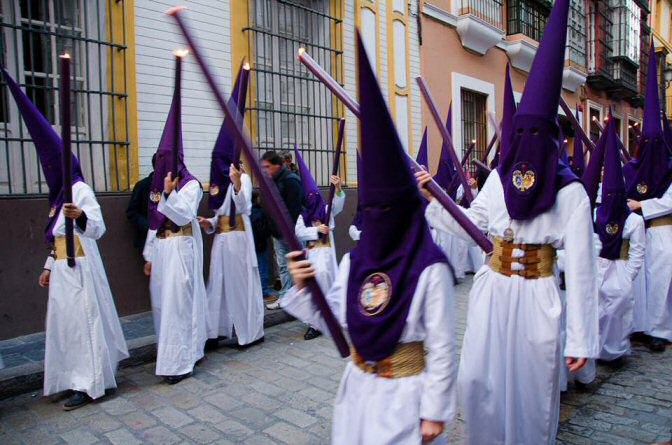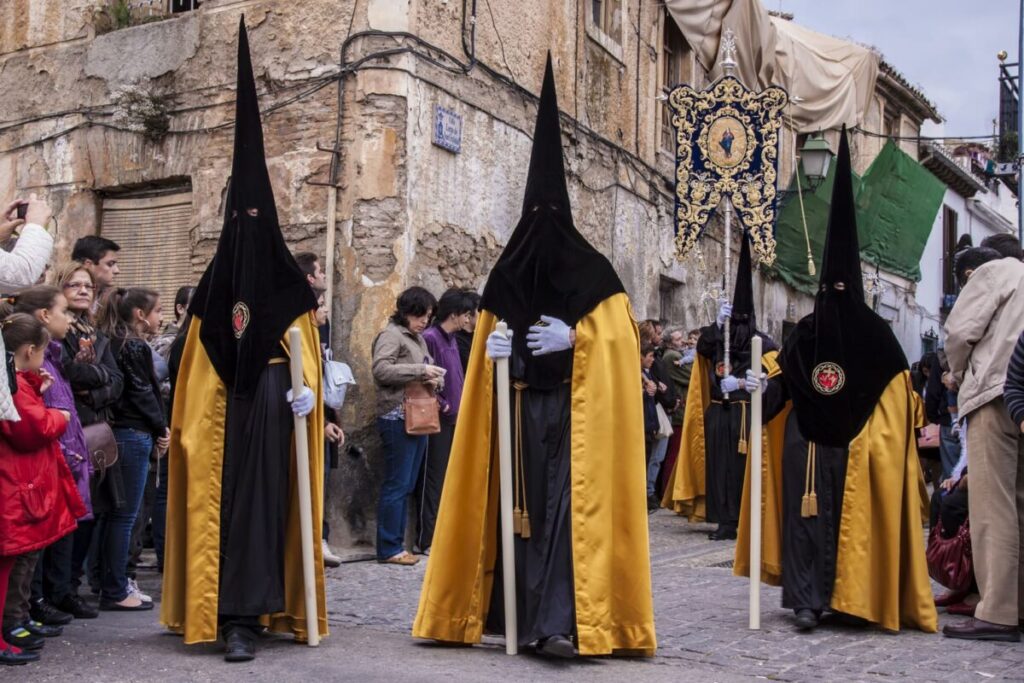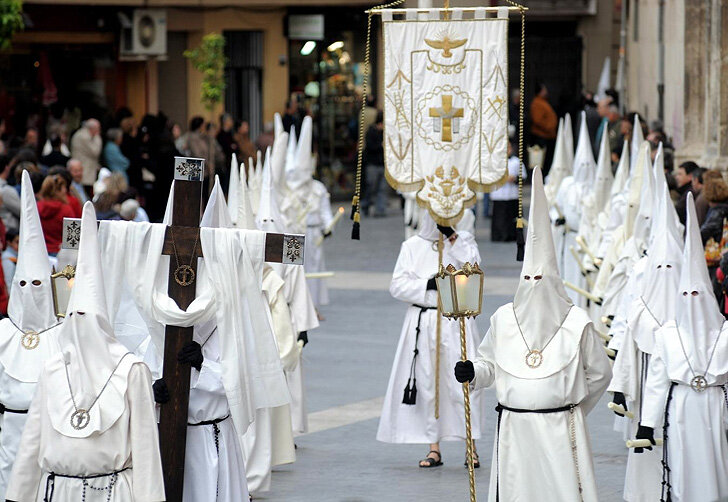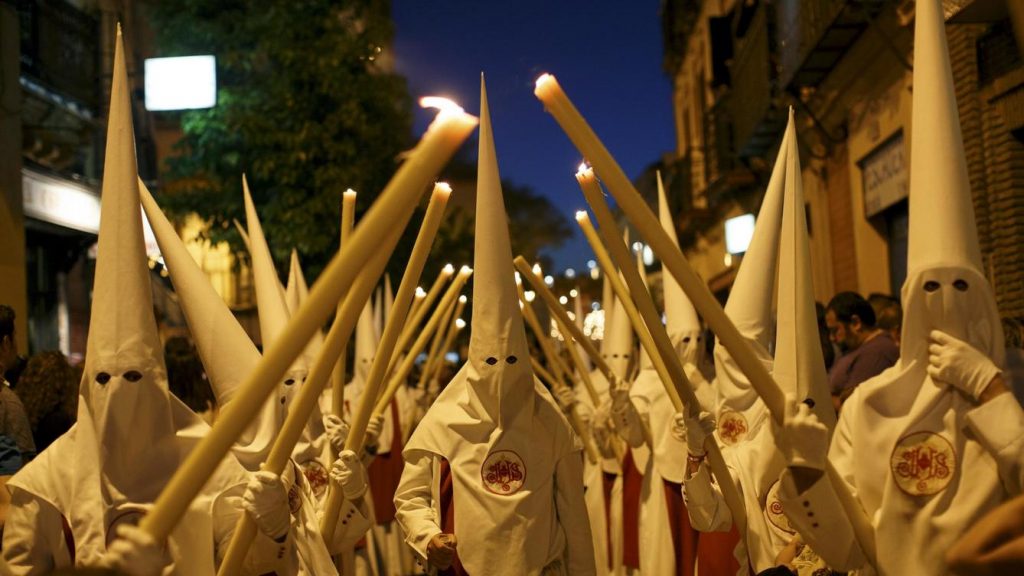What Is Holy Week In Spain: As “Semana Santa” is called in Spain, Holy Week is a religious and cultural holiday that goes above and beyond the norm. The whole country is filled with rituals, spirituality, and group devotion. It’s been a long, sad week before Easter. But this week is more than just a celebration; it’s a lively display of Spain’s rich cultural history, where religious and secular traditions live together in peace.

Spain has a beautiful holiday called Semana Santa, which lasts from Palm Sunday to Easter Sunday. It interests people in the area and brings people from all over the world. Holy Week is a time of deep religious worship, deep reflection, and a shared experience of Christ’s death on the cross. Every day of the week has its own set of celebrations, rituals, and tours. Religious brotherhoods play out scenes from the Bible in the streets.
In many cities, like Seville, Granada, Malaga, and Toledo, people celebrate Semana Santa with great enthusiasm, and they stick to customs that have been around for hundreds of years. The streets look like a dramatic painting when people dress up in fancy clothes, play sad traditional music, and ride on difficult processional floats.
How does Spain celebrate Holy Week?
Every day of Holy Week comes with religious processions in Sevilla. Accompanied by hooded penitents, elaborate floats bearing statues of Mary or Jesus are carried on the shoulders of strong men walking to churches through narrow streets lined with crowds.
In Spain, Semana Santa, or Holy Week, is observed in a unique way that combines religious zeal, community service, and old traditions. From Palm Sunday to Easter Sunday, people celebrate the Passion of Jesus Christ with a lot of fancy processions, liturgical rites, and traditions.
Comrades, or religious brotherhoods, play a big part in planning and carrying out these somber parades. Very well-made floats called pasos show scenes from the Bible. As they carry statues, crucifixes, and other holy items through the streets, the people taking part—many of them wearing traditional robes—make an arresting and intense scene.
Spanish towns all over the country celebrate Semana Santa with church services, processions, and other spiritual and cultural events. The streets come to life with bright decorations, lovely flower arrangements, and the spooky sounds of old music. From the happy celebrations of Palm Sunday to the serious events of Good Friday, each day of Holy Week has a different theme that builds up to the loud celebrations of Easter Sunday.
How does Spain traditionally observe Holy Week, or Semana Santa?
Spain has a long history of religious festivals, processions, and ceremonies that celebrate Jesus Christ’s Passion, Death, and Resurrection during Holy Week, which is also known as Semana Santa. The celebration starts on Palm Sunday and continues every day until Easter Sunday. All over the country, cities, and towns become lively places where people can celebrate their religion and culture.
Religious brotherhoods, or comrades, are very important when it comes to planning and carrying out processions during Semana Santa. One of the best parts of these processions is the pasos, which are artistic floats with religious themes. People who are there, who usually wear traditional clothes, march gravely through the streets, making an arresting sight.
The mood is very emotional, with sad music, prayers, and the steady beat of drums playing in the background during the processions. As each day comes, the focus changes to reflect a different part of the Passion, from Palm Sunday’s joyful entry into Jerusalem to Good Friday’s somber Via Crucis.
Semana Santa traditions are carefully passed down from one generation to the next. It’s a time for community devotion, reflection, and participation. In Spain, the spirit of Holy Week lives on as a strong expression of religion and cultural identity, though the details change from place to place.
Is Holy Week a good time to visit Spain?
Best for: festivals, fiestas and ferias
Richly vibrant culture is on full display in April as the country comes alive with several of Spain’s most dynamic festivals of the year. Semana Santa, or Holy Week, is a particularly epic festival that takes place in the week leading up to Easter Sunday.
It’s possible to have an interesting and educational trip to Spain during Holy Week, but each person’s tastes and travel goals must be taken into account. Semana Santa is a unique time to learn about Spain’s long history because of its beautiful processions, religious ceremonies, and lively cultural events.
For people who really want to learn about Spanish traditions, Holy Week in Seville, Granada, and Malaga is a powerful and real-time filled with local rituals. The beautiful processions, the smell of the incense, and the loud sounds of traditional music create a mood that is both solemn and joyful.
Also, remember that Semana Santa is one of the busiest and most crowded times of the year for tourists from Spain. There may be a lot of people looking for hotels in popular areas during big festivals, and the streets may be full of people going to mass. Travelers should plan, book their lodging, and be ready for any delays in regular services and schedules.
What is done during Holy Week?
During Holy Week, Christians recall the events leading up to Jesus’ death by crucifixion and, according to their faith, his Resurrection. The week includes five days of special significance. The first is Palm Sunday, which commemorates Jesus’ humble entry (on a donkey) into Jerusalem to observe Passover.
During Holy Week, which is also called Semana Santa in Spain, many religious and cultural events are held to remember Jesus Christ’s crucifixion, death, and resurrection. The main draw of the event is the grand processions led by religious brotherhoods, or comrades, in different towns and cities. People in traditional robes lead these processions, which have floats called pasos that show scenes from the Bible and are very well decorated.
During Holy Week, there are religious events and processions every day. On Good Friday, for example, the solemn Via Crucis is remembered, and on Palm Sunday, Jesus’ happy entry into Jerusalem is placed. The most important event of the week is religious services, which include Masses, prayers, and quiet times for reflection. These services encourage devotion and reflection within the community.
You can see how communities have taken part by putting up flower displays and decorations and playing happy traditional music everywhere you look. The processions give both Spanish people and visitors a unique chance to experience the country’s rich religious and cultural history in a beautiful and emotional setting during this important week of remembrance.
What are the main religious and cultural components of Semana Santa in Spain?
In Spain, Semana Santa is a unique mix of religious zeal and cultural expression that weaves together religious and secular traditions into a complex web of traditions. The most important spiritual parts are celebrating the suffering, death, and resurrection of Jesus Christ. A big part of these events is the long processions led by comrades, which are religious brotherhoods. These processions are known for their fancy floats, called pasos, that show biblical themes. A steady drum beat and traditional melodies play in the background.
Cultural elements can be seen in how carefully centuries-old traditions are kept alive, with each place adding its special touch to the celebrations. Active participation in the local community builds a sense of identity and community. The cultural show is made better by the brightly colored street decorations, the intricate float decorations, and the participants’ one-of-a-kind clothes.
During Semana Santa, there is a strong sense of spiritual introspection and solemn religious rituals that make this time of community devotion stand out. During this one-of-a-kind week, the streets of cities and villages in Spain become living paintings that show how deeply faith and tradition are linked. This is possible because religious and cultural elements come together to create an immersive experience.
What is the Holy Week in Spanish speaking countries?
“The final week of Lent (Cuaresma) is known as Holy Week. In Spanish-speaking countries it is called Semana Santa (show pronunciation on board- Say-MAH-na SAHN-ta). During Holy Week there are slow, sorrowful processions (las procesiones) in many cities of Latin America.
In Spanish-speaking countries, Holy Week is called Semana Santa. It is a very culturally rich event that goes beyond its religious roots to show how religion, customs, and community work together. During Semana Santa, there are big processions, religious ceremonies, and cultural events all over Spain, Latin America, and other Spanish-speaking countries.
People all over Spain know Seville, Granada, and Malaga for their fancy parades called pasos. These floats show scenes from the Passion of Christ. Cofradas, which are religious brotherhoods, are very important in planning these events, which make for an interesting and dramatic setting. A lot of Latin American countries have their ways of celebrating Semana Santa. Some examples are Guatemala, Mexico, and Peru. The event is made up of processions, reenactments, and religious rites that often combine native customs.
During Semana Santa, the streets are filled with bright flowers, traditional music, and people. It is a time for everyone to reflect on their culture and work together to strengthen it. The celebration makes Holy Week a beloved and culturally important time for Spanish-speaking people all over the world. It gives people of all religions a strong sense of spiritual devotion and an immersive experience.

What Happens During The Holy Week in Spain?
Spain’s Semana Santa, or Holy Week, is a time when many old traditions, religious fervor, and ways of expressing community come to life. The activities begin on Palm Sunday and continue until Easter Sunday. It consists of numerous grandiose processions, religious rituals, and cultural celebrations. Cofradas, or religious fraternities, prepare and engage in these extravagant processions that feature elaborate floats, or pasos, that depict scenes from Christ’s Passion.
Every day of Holy Week, there are special events that connect to different parts of the biblical tale. The haunting sounds of traditional music and the steady beat of drums follow the marching participants, who are often dressed in traditional robes, creating an emotionally charged scene. The large processions of towns such as Seville, Granada, and Malaga are particularly well-known.
Communities deck the streets with brilliant decorations, magnificent floral displays, and religious icons during Semana Santa. Religious ceremonies, such as prayers and Masses, promote a sense of community. During the observance, faith, customs, and community join together to create an immersive experience that transforms Holy Week into a time of deep spiritual reflection and cultural celebration across Spain.
Holy Week in Spain
Holy Week, or Semana Santa, is a varied and highly cultural event in Spain that includes a wide spectrum of religious devotion and community expression. The week, which begins on Palm Sunday and finishes on Easter Sunday, is celebrated in cities and villages around the country with elaborate processions, religious rites, and traditional customs.
The organizations that plan the painstakingly organized processions are known as comrades or religious brotherhoods. Participants carry elaborate floats, known as pasos, representing scenes from Christ’s Passion. They frequently wear traditional outfits. Traditional music, along with the rhythmic pounding of drums, provides a spiritual and emotional atmosphere on the streets.
Large processions that enchant both locals and tourists are especially well-known in towns such as Seville, Granada, and Malaga. Semana Santa is more than just religious observances; towns actively join in street celebrations, extravagant floral displays, and colorful decorations.

Semana Santa is a unique and immersive experience that brings together faith, tradition, and community. It is a significant reflection of Spain’s rich culture and religious past. Holy Week continuously shapes Spain’s national identity and develops a strong sense of shared cultural pride.
Holy Week, or Semana Santa in Spain, is a compelling tapestry of faith, history, and cultural identity that goes beyond religious practice. It is the country’s most important and elaborate religious celebration, embodying the essence of Spain’s rich heritage and uniting communities in a shared experience that transcends the spiritual.
The religious brotherhoods’ laborious planning and execution of processions, the wearing of traditional costumes, and the rhythmic pounding of drums create a highly emotional and reverent ambiance throughout the week. Grand processions take place in vibrant towns like Seville, Granada, and Malaga, inviting tourists and residents from all over the world to experience the spirit of Spanish culture.
Semana Santa is a cultural holiday in which locals join by decorating the streets with brilliant lights, extravagant floral displays, and religious symbols. The festival shows Spain’s ability to blend deeply rooted customs with a sense of modern identity.



